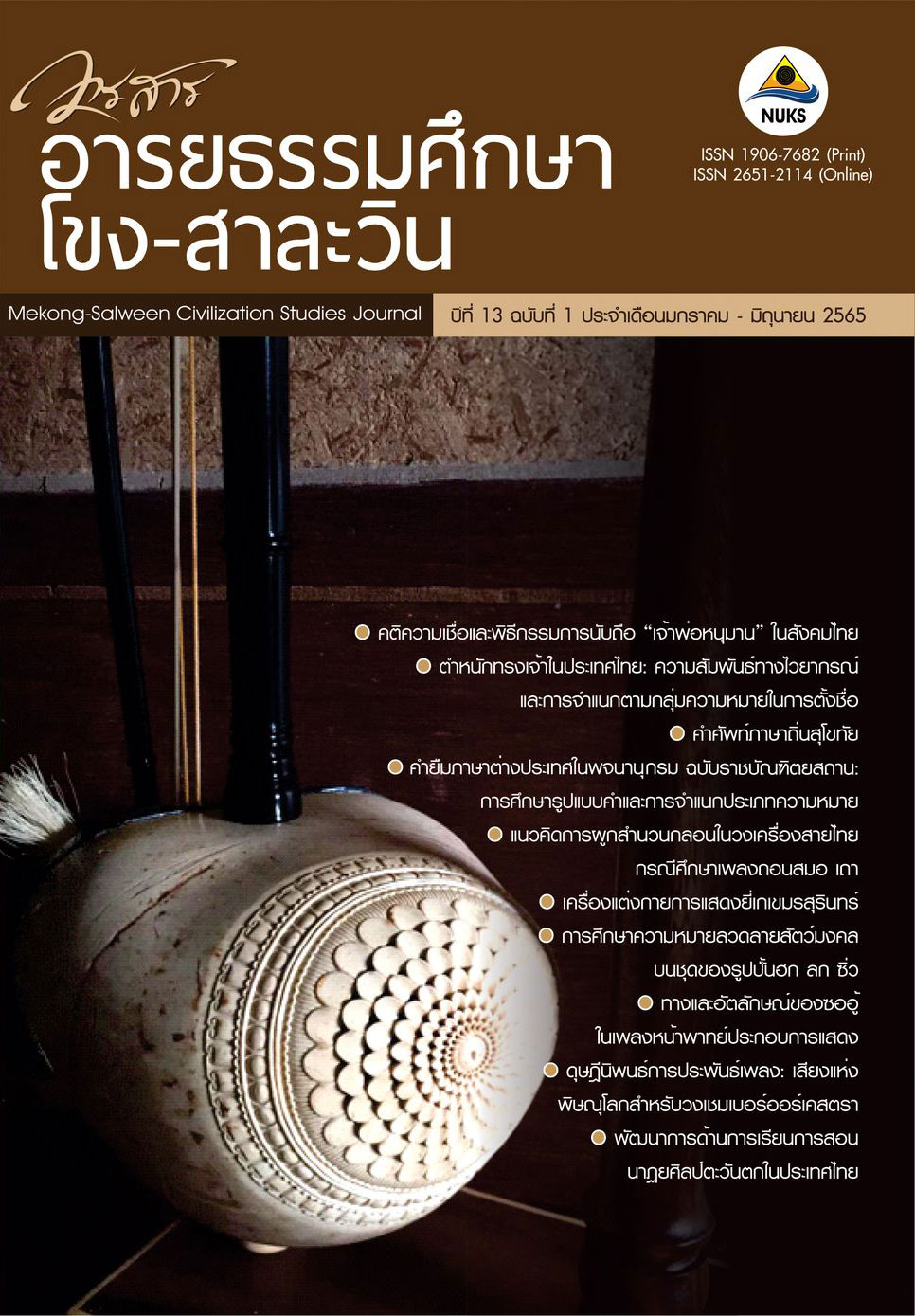Foreign Language Loan Words in Royal Institute Dictionary: A Study of Word Forms and Semantic Categories คำยืมภาษาต่างประเทศในพจนานุกรม ฉบับราชบัณฑิตยสถาน: การศึกษารูปแบบคำและการจำแนกประเภทความหมาย
Main Article Content
Abstract
The objective of this study was to analyze the forms of loan words and semantic categories in the Royal Institute Thai dictionary of the edition 2011. This study only studied loan words in foreign languages that the dictionary abbreviated (i.e., 15 languages which were Khmer, Chinese, Javanese, Vietnamese, Japanese, Mon, Bengali, Persian, Portuguese, French, Malay, Latin, English, Arabic and Hindi). This study found that there were a total of 1,710 loan words. The English loan words were highest (883 words or 51.64%). It was followed by Khmer loan words (430 words or 25.15%), and Chinese loan words (142 words or 8.30%). The number of Latin and Vietnamese loan words was lowest (2 words per language or 0.11 %). Foreign language loan words in Thai language were found in 8 forms, consisting of 1-syllable words, 2-syllable words, 3-syllable words, 4-syllable words, 5-syllable words, 6-syllable words, 7-syllable words, and 8-syllable words. The most common word form was 2-syllable words (795 words or 46.49%), followed by 3-syllable words (377 words or 22.04 %), and 1-syllable words (308 words or 18.01%). 8-syllable words were found the least (3 words or 0.18%). As for the semantic categories, it can be grouped into 17 groups. It was found that the meanings of most loan words were related to education, science, and technology, (447 words or 26.14%), followed by the meanings about nature and environment (195 words or 11.40%) and meaning about act (184 words or 10.76%). The meaning about vehicles was lowest (17 words or 0.99%). The results of this research will be beneficial to linguists who are interested in studying patterns of borrowed words and meaning groups of foreign language borrowings in the Thai language and will assist them to understand the characteristics of foreign language loan words. It is also a way to study society and culture from borrowed words.
Downloads
Article Details

This work is licensed under a Creative Commons Attribution-NonCommercial-NoDerivatives 4.0 International License.
References
Ammaraphithak, (1996). Pali and Sanskrit loanwords in the Mahabharata Yut of Suphorn Pholchewin (Master’s Thesis). Srinakharinwirot University, Bangkok.
Changkhwanyeun, W. (2012). Thai norms (volume 2) : word formation and word borrowing. Bangkok : Thai language institute Office of Academic Affairs.
Jansiiha, S. (1999). Study of changes in Pali and Sanskrit borrowings that appear in Phra Pathom Solemnity (Master’s Thesis). Mahasarakham University, Mahasarakham.
Jaikhlam, S. (2006). Pali -Sanskrit words and meanings in the Dictionary of the Royal Institute of Thailand 1982 and 1999 (Master’s Thesis). Naresuan University, Phitsanulok.
Jiaphong, S. (2020). Foreign languages in Thai. Phitsanulok : Phibulsongkhram Rajabhat University.
Jiaphong, S. (2017). Principles of language and usage of Thai language (2th ed.). Phitsanulok : Kanphim.com.
Jiaphong, S., Phongsree, P., & Phungsak, R. (2018). A Study foreign loanwords in new word dictionary of The Royal Institute, National Academic Conference (pp. 717-727). Phitsanulok: Naresuan University.
Jittawiriyaphong, J. (2003). The influence of foreign languages in Thai language. Bangkok : King Mongkut's Institute of Technology Ladkrabang.
Khwanmongkhol, S. (1992). The study of changes in the meaning of the Sanskrit Pali from the Dictionary of the Royal Academy, BE 2525 : A Case Study of Literature The story of the Great Vessantara Jataka, the 13th (Master’s Thesis). Naresuan University, Phitsanulok.
Kingkham, W. (2007). Foreign languages in Thai. Bangkok : Thammasart University.
Kittikul, N. (1991). Hokkien Chinese loan words used in the local Thai language Phuket Province (Master’s Thesis). Srinakharinwirot University, Bangkok.
Ledamornmeesuk, S. (2013). Development of Chinese loan words in Thai dictionaries (Master’s Thesis). Sillapakhon University, Nakhonpathom.
Nida, A. (1975). A Componential Analysis of Meaning. Mouton: The Hague.
Niyommee, U. (1991). Pali and Sanskrit borrowed words in the Mahachat Kham Luang Kanthosaporn (Master’s Thesis). Sillapakhon University, Nakhonpathom.
Ondee, P. (1988). Pali and Sanskrit loanwords in Thai language during the Ayutthaya period. (Master’s Thesis). Sillapakhon University, Nakhonpathom.
Phatthumetha, N. (2016). Word Corpus. Bangkok : Ammarin printing and publishing.
Pramolsinchai, S. (1998). Language Culture of Loan Words Appeared in the Royal Thai Dictionary 1982 Edition (Master’s Thesis). Srinakharinwirot University, Mahasarakham.
Pungfeung, S., & Srikulki, P. (2019). Foreign languages in Thai. Phitsanulok : Mahachulalongkornrajavidyalaya University.
Royal Institute. (2007). New Word Dictionary Royal Institute Edition, Volume 1. Bangkok : Royal Academy.
Royal Institute. (2013). Dictionary of the Royal Institute of Thailand 2011. Bangkok : Royal Academy.
Sriratchaphat, P. (1987). An analytical study of Pali-Sanskrit in local literature Nakhon Si Thammarat the genre of fairy tales and teachings (Master’s Thesis). Chulalong University, Bangkok.
Sittisuphaset, N. (2006). Analysis of Pali Sanskrit terminology in Lanna literature (Master’s Thesis). Chaingmai University, Chaingmai.
Talapnak, S. (2013). A study of academic achievement in foreign language borrowings in Thai language of Mathayom Suksa 2 students who manage to learn 4 MAT (Master’s Thesis). Sillapakhon University, Nakhonpathom.
Watthanaphan, S. (1994). Characteristics of Javanese-Malay loanwords in the play of Dalang and Inao (Master’s Thesis). Sillapakhon University, Nakhonpathom.


